Small agency problems only compound as you grow—going from minor inconveniences to massive headaches.
Sure, your revenue goes up as you scale. But without addressing the inefficiencies that lie at your agency’s foundation, it won’t be sustainable. You’ll have issues with profitability, productivity, and further growth.
To discuss solutions, we spoke with agency operations expert Manish Kapur, who brings over 25 years of experience to the table.
He identified four key categories for growing agencies to evaluate:
- Leadership
- People
- Financial Management
- Processes
In this article, we’ll break down these areas, highlight common pitfalls, and offer tips you can implement right away to strengthen your agency.
1. Leadership: Your agency’s direction starts here
As agencies scale, it’s common to promote top-performing individual contributors. Because their technical skills or tenure should set them up to be a great leader, right?
Not necessarily.
Without the right support, structure, or training on how to lead, these high-performing employees struggle to do so. And this lack of preparedness leads to:
- Slow decision-making that causes missed deadlines and client frustration
- Overwhelmed team leads who don’t know how to balance project work and people management
- Ineffective delegation that traps senior talent in the weeds and drives burnout and disengagement
People don’t leave companies—they leave bad bosses.
As Manish points out, anyone in a managerial position should have some kind of leadership development and training.
Don’t just assume people will “figure it out.” Instead, take a proactive approach to set your leaders (and agency) up for success.
Here are two ways to do it:
Look backward: Assess your leadership team and their needs
By looking at the strengths and weaknesses of your leadership team members, you can figure out where they need extra training and support.
You can do this on a regular cadence—say, with monthly leadership check-ins—or as part of a larger agency audit after a “trigger event.” Like a big reorg.
These check-ins help create a culture of openness and learning where people can honestly share how they feel and what they need more support with.
Make sure you talk to both leaders and their team members or direct reports. Ask focused, direct questions like:
- What’s working well?
- What recurring issues or bottlenecks slow down your work?
- Where do you need more support?
Manish also suggests zeroing in on responses related to these core managerial skills:
- Delegation
- Time management
- People management
- Communication
- Team building
- Decision-making
Then, document key takeaways and help managers set specific goals to work toward.
Most importantly, Manish said, don’t criticize team members for their weaker areas or needing help—we all have room to improve!
Look forward: Provide targeted leadership training and support
Once you’ve identified where managers need support, it’s time to give it to them.
Structured development should include both active training (like courses or workshops) and passive training (like self-directed learning or team-wide playbooks).
This makes a measurable difference for employees — and for your agency. 58% of companies that said they had clear growth paths and development for employees were also exceeding their employee engagement and retention goals.
Consider:
- Finding training programs for the most common skills gaps. Online training programs (e.g., leadership courses on Udemy or Coursera, targeted classes from Dale Carnegie or Mark Ritson) are a great way to help team members upskill in specific areas. Or you can work with an external expert to create custom trainings for your team.
- Pairing new leaders with internal mentors or specialized coaches. Regular mentorship and coaching can give new leaders the support they need to thrive in their new role.
- Creating a Slack channel where managers can support each other. A place where managers can easily connect and ask questions goes a long way to creating a culture of learning and development.
- Creating a leadership playbook with agency-specific best practices. This is a tip Zoë Elizabeth Blogg, operations director at Reboot, shared with us. Setting up a leadership playbook with managerial expectations, training, and tips gives all managers a strong foundation to grow from. And helps new leaders hit the ground running.
Top Tip
Dive even deeper into leadership training with our podcast episodes featuring Trenton Moss, Isobel Camier, Zoe Blogg, and Amy Hopper (or reach out to them to discuss training opportunities for your team).
2. People: Retaining talent is as important as finding it
Your people are your biggest asset. But too often, agencies focus all their energy on finding great talent, not keeping it or developing it.
It amazes me how long agencies spend hiring people—and how little time they spend retaining them.
When teams and people aren’t invested in intentionally, it leads to:
- High turnover, which disrupts project delivery and quality (and creates expensive recruiting and staffing costs).
- Disengaged employees who don’t have a clear sense of career growth or support to do their best work. According to a recent Gallup study, only 31% of employees feel engaged at work—and around the same percentage of employees said they worked at companies that invested in their learning and development.
- Team stagnation and inefficiency due to inconsistent onboarding and development.
To scale successfully, you need to support people from day one—and give them reasons to stay for the long run.
Create a solid onboarding process
Like Manish says, retaining talent starts right from the beginning.
A solid onboarding process shows new hires what they can expect from your leadership, from your team culture, and from their role.
Outlining how to do their job well—and how they can grow—helps inspire confidence in new workers about your agency and their future in it.
Here’s how to make onboarding seamless:
- Design a 90-day plan. A three-month onboarding plan gives new hires a clear roadmap for what they’re responsible for and how they can measure their own progress. Include things like clear milestones for the first 90 days, expectations for their role, and info about your team’s tech stack
- Foster connections right away. Set up meetings with managers and core team members early. This way, new hires can ask questions, get to know their team, and understand the day-to-day culture of your agency.
- Use structured templates to ensure consistency across roles. Templates, processes, and checklists help ensure every new hire gets the same (or a similar) onboarding experience—and make it easier for new managers to onboard team members successfully.
Top Tip
Check out our conversation with Sarah Brougham for more key tips on onboarding programs that get new hires off to a running start.
Create a clear career progression framework
If employees feel like there’s no growth potential at your agency, they’ll start looking elsewhere. Especially if a recruiter tempts them with a higher salary.
And this disengagement and turnover costs your agency. On average, replacing an employee costs between half to four times their annual salary.
So if you’ve got an employee who makes $70,000 a year and lose them to disengagement, you could spend up to $280,000 to replace them.
Retain your employees and keep them engaged with a clear path for professional development and growth.
Progression beats pay. People will stay if they believe they’re growing—even if they could earn more somewhere else.
Case in point: 94% of employees in a survey stated they would stay at their company longer if the company invested in their professional growth.
Keep team members committed by:
- Setting a clear path to growth for each role. Define “levels and ladders” for each department (i.e., how to move from junior → senior → lead roles). And make sure the markers of success are consistent. For example, a junior design should have similar “green flags” for promotion as a junior copywriter.
- Offering individual development plans: Some team members might want to move laterally—or move into a whole other department. Work with them to create tailored roadmaps to help them reach their unique goals.
- Showing your support: Actively support employees when the change they’re waiting for (e.g, a promotion, role shift) gets stalled. Emphasize that you understand their frustration and look for other ways to help them grow in the meantime, whether through different training, team shadowing, or side projects.
All of these actions increase employee trust, reduce turnover, and give you the best chance to develop industry-leading talent that stays invested in your agency.
Optimize performance reviews
Performance reviews are a powerful retention tool—if they’re done well.
But many agencies rely on rushed annual reviews (or skip them entirely), leaving people in the dark about how they’re doing and where they’re headed.
This not only means you miss opportunities to develop talent within your team, but it also creates disengaged employees. And can lead to high turnover.
Instead, Manish recommends looking at performance reviews as a continuous, collaborative process:
It’s not about a one-off review—it’s about making sure you’re there on a regular basis, on their side, helping them achieve the goals they want to achieve. Really spend the time with your people to ensure they’ve got a clear path and can see how they’re going to grow and develop within your company.
Manish’s other tips on making performance reviews less painful for everyone?
To recap:
| Avoid this: | Do this instead: |
|---|---|
| Avoid This | Do This Instead |
| ❌One-off, annual reviews | ✔️Run quarterly check-ins and performance reviews with monthly follow-ups |
| ❌Siloed feedback from a single person, such as a manager | ✔️Get 360° feedback by including feedback from peers and other managers who work closely with them |
| ❌Ad-hoc review processes created by individual managers | ✔️Set and use consistent templates and guidelines to shape reviews |
| ❌Expecting managers to know how to do this effortlessly | ✔️Train managers in active listening, open-ending coaching questions, and giving constructive feedback |
| ❌The assumption that team members will be able to achieve their goals on their own | ✔️Prioritize ongoing support and training |
Top Tip
See how Zoe Blogg designs career pathways and performance review frameworks that keeps team members motivated and growing.
3. Financial management: Growing revenue ≠ growing profit
You land a few big clients, hire some new employees, and take on more work than ever—but your margins shrink, your burn rate spikes, and your profitability isn’t budging.
Why?
Because your level of financial management hasn’t scaled with your agency.
You can grow revenue and still be less profitable than you were half the size. That’s a huge red flag.
According to Manish, most agencies only focus on financial oversight after the cracks start to show. But by then, it’s often too late for a quick fix.
Profitability doesn’t just magically happen. It requires teams who know how to:
- Forecast well: Look at the data and see what’s going to happen in the future, not just what’s already happened
- Manage clients well: Find the right clients and projects to grow profitability—not just revenue
- Hire well: Optimize for resource utilization and profitability before jumping to increase staffing
- Price well: Scope and price projects accurately to support sustainable profits
Here’s some tips from Manish for each of those:
Forecast well: Track leading indicators (not just past performance)
Most agencies only look at lagging indicators, like last month’s revenue, billable utilization, or Profit & Loss (P&L) statements.
And while these are useful metrics, they’re reactive metrics.
To stay profitable, you can’t just look at what’s happened. You need to know what’s going to happen.
Having a financial forecast is key. We’ve all got targets, but knowing exactly where the work’s going to come in. A financial forecast is one of the best tools a resource manager can have.
So add the following leading indicators to your financial forecast:
- Forecasted revenue (three to six months out)
- Confirmed pipeline vs. resource capacity
- Upcoming staff availability
These metrics help you make more informed decisions about staffing to better support your margins and team.
Say you see you’ve got a lot of profitable work coming up, but your team is already at capacity. You’d know to evaluate hiring or bring on freelancers to fill those gaps.
But if your forecasted revenue and confirmed pipeline are low, you’ll know you need to increase sales to meet your goals.
Here’s how to monitor these leading metrics in Scoro:
For forecasted revenue, use the “Revenue” report to get a forward-looking view of income:
- Quotes (potential revenue) appear in light blue
- Projects (confirmed revenue) appear in dark blue
You can also use the “Quote status” filter to only show quotes in later stages. This way, you don’t accidentally inflate your pipeline.
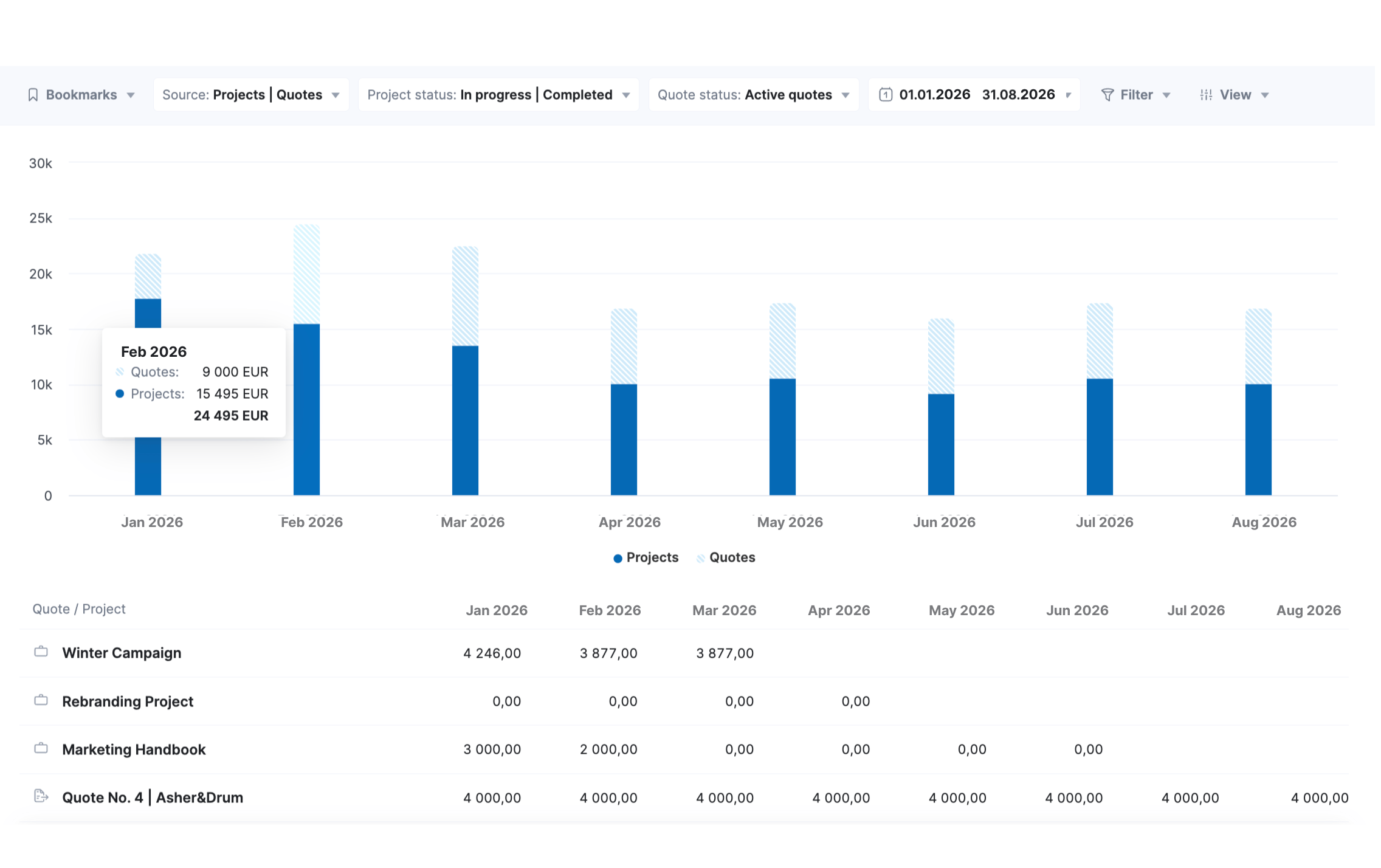
Then, use the “Bookings” module for accurate resource planning.
The heatmap shows each team member’s workload by day, week, or month:
- Solid background = Confirmed bookings
- Striped background = Tentative bookings
- Green cells = Available capacity (underbooked)
- Red cells = Overbooked
By layering in tentative bookings tied to deals in the pipeline, you can simulate future workload and see how your team would handle it before anything is confirmed.
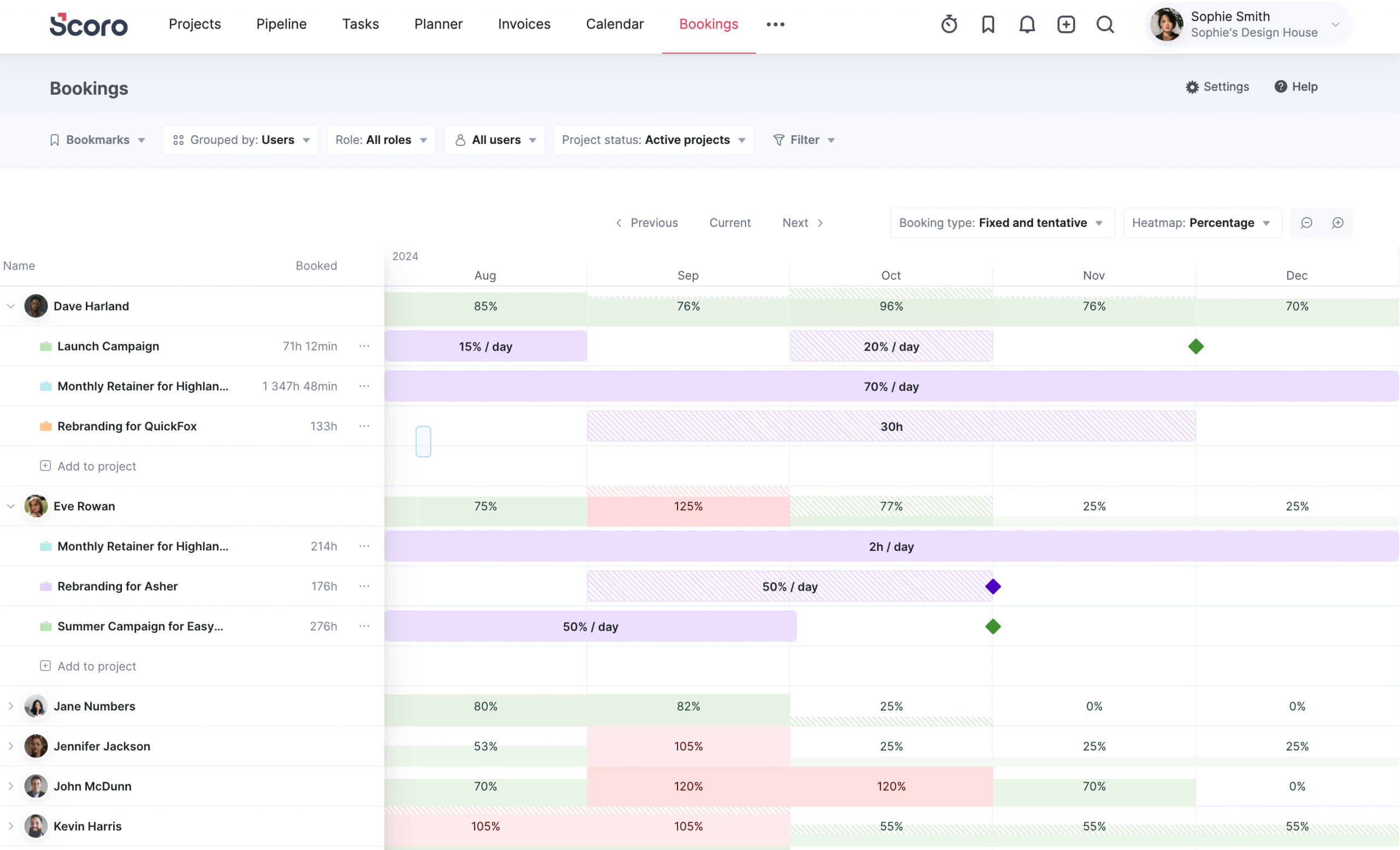
Use these reports together to make sure you have enough work coming in—but not more than your current team can handle.
Manage clients well: Analyze profitability by client and project
Profitability doesn’t just happen by itself—you have to really work for it. Look at how profitable you are with certain clients. And if there’s certain clients, teams, or projects that are really driving profitability.
Topline revenue can be misleading. One large client might represent 30% of your revenue, but only 5% of your profit.
For a true picture of financial health, focus more on profitability for each client and project. This way, you’ll know where financial gains (and losses) are coming from.
Aim for a net profit margin of 15% to 35%. This healthy range means you covered costs while still making a profit.
Check both client and project profitability in Scoro’s “Project list” view.
Select the “Grouped by: “Clients” filter. Then, use the “View” filter to select “Income,” “External cost,” “Labor cost,” and “Project profit” to see the data for different clients:
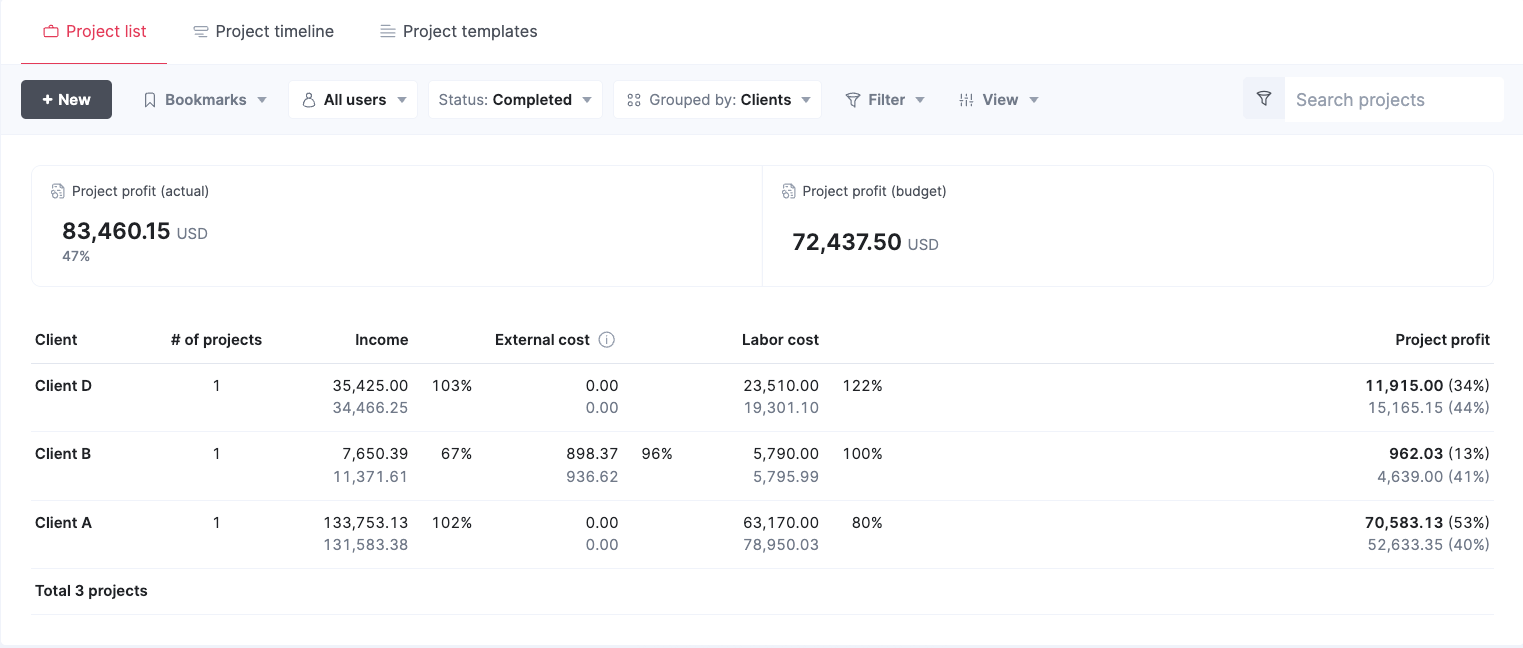
Now compare each client’s revenue against their costs and profit margins.
For example:
- Client A brought in over $133,000 and generated more than $70,000 in profit, with a 53% margin.
- Client D earned $35,425 in revenue and delivered $11,915 in profit, for a 34% margin.
- Meanwhile, Client B only produced $962 in profit on $7,650 of income—a much thinner 13% margin.
Use this view to assess whether your biggest clients are truly your most profitable—and whether high-effort clients are worth keeping long-term.
You can also view profit by individual projects by viewing the “Profitability by projects” report.
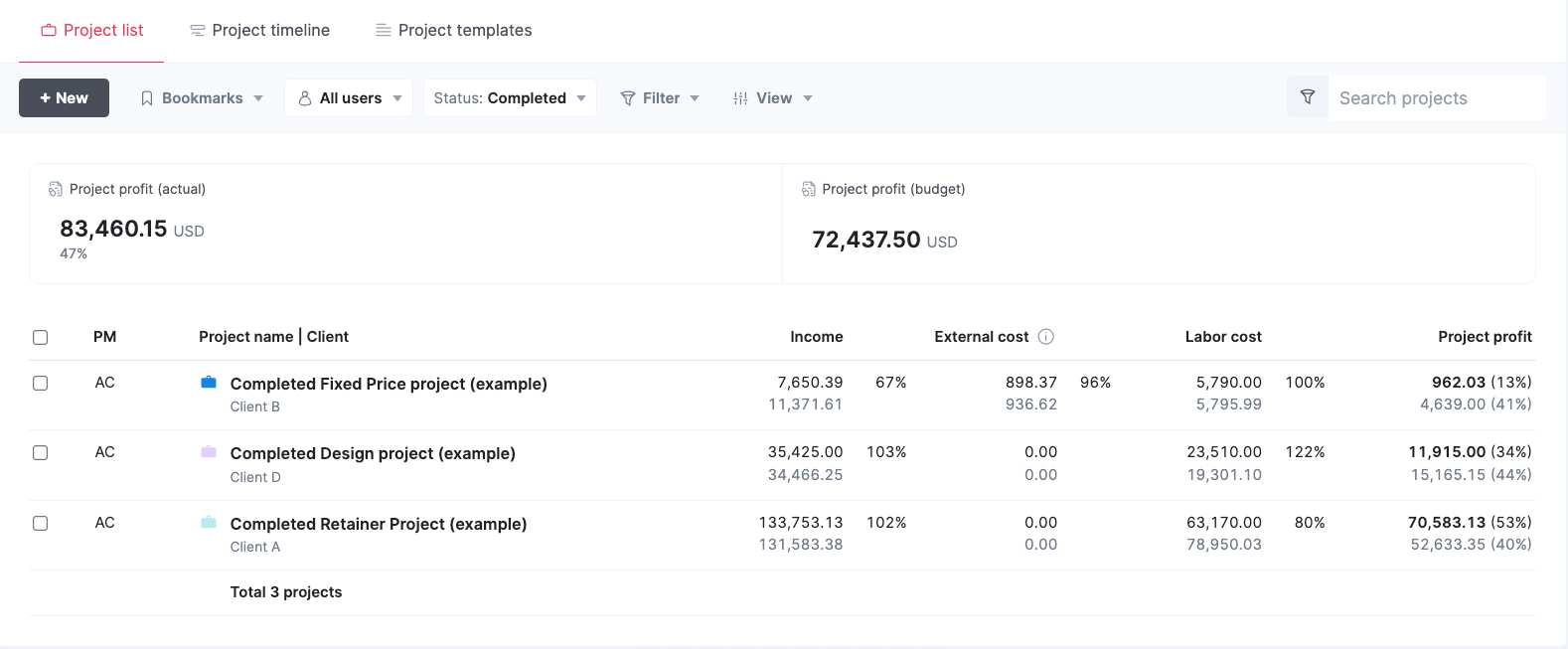
If you notice low margins on certain projects, compare your estimated versus actual hours spent on the project. Did you overservice? If so, why?
Consider adding a 20% scope buffer into future quotes to keep your margins healthier. Or increase pricing to better align with your project cost estimates and profitability goals.
Hire well: Optimize utilization before hiring
When you see way more work coming in, it’s natural to want to hire more staff. But, As Manish notes, you need to check your utilization rates before you do.
This way, you see if the solution really is investing in hiring—or if you just need to rebalance some workloads.
Aim for a target utilization of 75-80% for individual contributors. This means people have enough revenue-generating work on their plates but still have time for non-billable meetings, admin tasks, and internal projects.
- If team members are consistently underutilized (70% or less), you’ll know you can confidently bring in more work before needing to hire.
- If team members are consistently over the target range, you’ll need to either up the freelance support or hire additional full-time staff.
You can calculate billable utilization manually. But it’s a lot easier (and more accurate) if you use a resource management tool like Scoro that automatically calculates it in real time.
Head to the “Bookings” module to check utilization by percentages, booked hours, or remaining hours.
Green indicates booked billable work, while white spaces show team members’ remaining capacity. Red blocks indicate team members who are at or above 100% utilization.
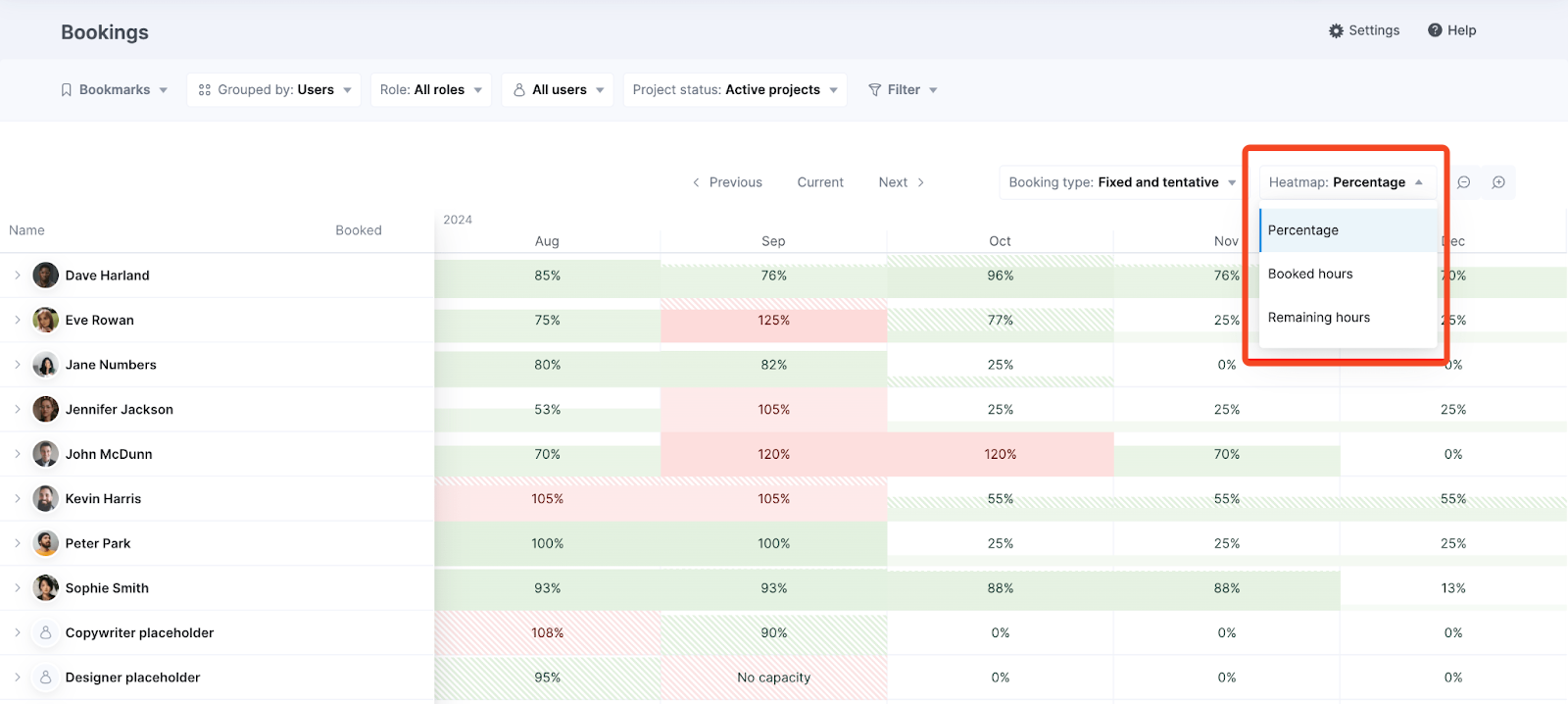
Further reading: Improve Your Utilization Rate: 8 Ways to Increase Billable Time
Price well: Regularly audit your pricing strategy
Pricing usually doesn’t evolve as fast as the agency does.
If you haven’t updated your pricing in over a year—or if your team consistently goes over budget—you may be undercharging.
Make it a goal to audit and refresh pricing at least once a year. This way, you can adjust rates to better cover your current overhead and operating costs. And make sure you hit your margin targets.
It’s also helpful to identify the clients and services that bring in the most (and least) value. Then, you can phase out projects with consistently low margins, while focusing more on lucrative work.
Use Scoro’s “Project list” to find your most valuable clients. Sort by “Completed” projects, then add the “View” > “Data column” > “Average billable rate.”
Then, you can quickly see your ABR per project based on labor costs, time, and revenue generated.

Then, look to sell more work that’s similar to those with higher ABRs. And phase out projects with lower ones (or increase pricing for those services).
4. Process: The key to scaling without chaos
As your team grows, inconsistent ways of working lead to bigger issues:
- Poor deliverable quality, leading to frustrated clients
- Less-profitable projects, with teams spending too much time chasing down approvals and documents
- Costly scope creep from vague project planning
- Knowledge siloes and inaccurate data that make it difficult for teams to work efficiently
Creating clear processes helps you avoid these problems.
Processes aren’t about creating rigid systems—they’re about helping people do great work without confusion.
He shares two main ways to embed great processes into your team:
Concentrate on best practices
Processes shouldn’t feel like red tape. Instead, focus on creating simple, consistent standards that protect quality and reduce chaos—especially as you scale.
What’s more important [than processes] is implementing best practices. So you can map out a process and say, this is how we need to get from A to B. But more importantly, what are the things that if we don’t do, the project will get derailed and we won’t successfully deliver it?
Manish talks about agile best practices here:
Some examples include:
- Project briefs: No matter how small the project is, outline the key info your team needs to succeed and meet client expectations
- Kickoff checklists: Standardizing your first project touchpoints ensures the work starts smoothly and keeps your team and clients on the same page
- Internal reviews: A standardized process helps ensure consistent quality across deliverables—without causing lengthy delays
- Post-project retrospectives: Use every major project to learn and improve, reviewing delivery margins, utilization, and other metrics you’re tracking
Be sure to roll out new best practices slowly—you don’t want to overwhelm your team.
Start with three critical ones that address the biggest pain points first.
Top Tip
Dive deeper into processes and best practices—and how to implement them in a way that sticks—in this episode on documenting and embedding processes with Harv Nagra
Optimize your tech stack
Project management tools, time tracking tools, invoicing tools—agencies often have a bunch of platforms in their tech stack.
But as you grow, those separate tools create confusion and inaccurate data. Not to mention all the non-billable time spent bouncing between systems.
I’ve seen agencies with five disconnected systems that don’t speak to each other—and everyone’s using them differently.
If this sounds familiar, here’s how to fix it:
- Audit your current tech stack. What’s essential? What’s duplicative? What causes the most friction? Which tools are the most expensive?
- Consolidate whenever possible. Never have two tools where one will do. Look at all-in-one systems like Scoro that let you manage everything from resource planning to invoicing from one spot.
- Automate repetitive tasks. Tools like Zapier and Make let you streamline workflows between platforms. For example, you can use Zapier to create a new task in Scoro from certain Slack messages. Or update a client profile based on a Gmail message.
Top Tip
Check out our podcast episode with Tyler Caskey, who talked us through how consolidating tools and automation helped transform his agency.
Don’t wait for a crisis to fix these critical areas
Many agencies only address operational challenges when they hit a breaking point. But the key to sustainable growth is proactively building strong leadership, people, financial management, and processes before problems arise.
If you’re not sure where to start, take Manish’s free agency assessment tool to evaluate your agency’s strengths and weaknesses.
Then, see how a PSA tool like Scoro can help you get the visibility, data, and organization you need to address and optimize these areas.
For more agency tips and tricks, check out these other podcast episodes of “The Handbook:”
- “The Real Role of Ops: Revenue & Growth Driver” with Ryan McNamara
- “How to Move from Tactical to Strategic Ops” with Preston Chandler
- “Why Your Tools Aren’t Talking — and What It’s Costing You” with Ryan Pearcy






